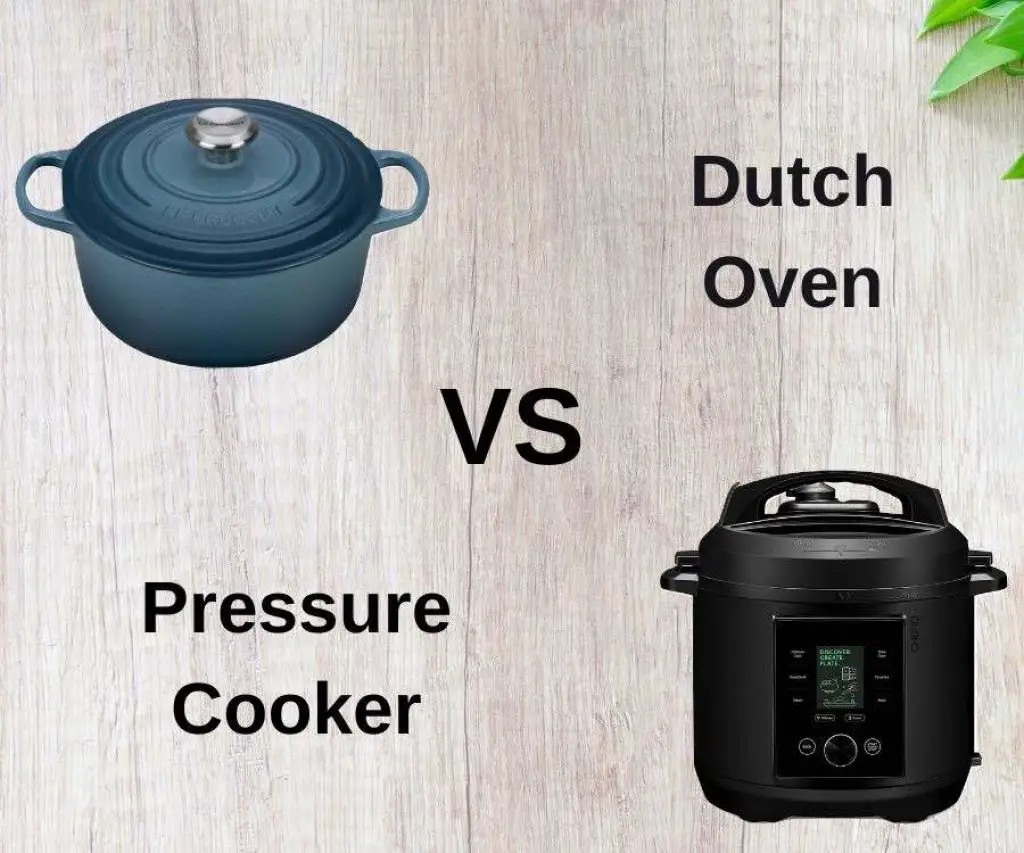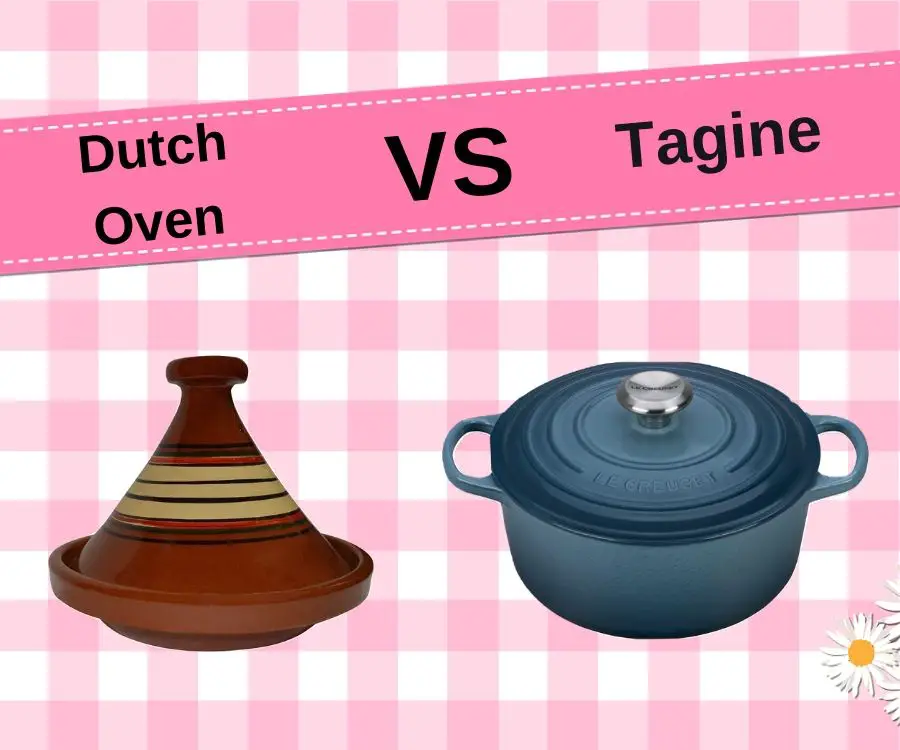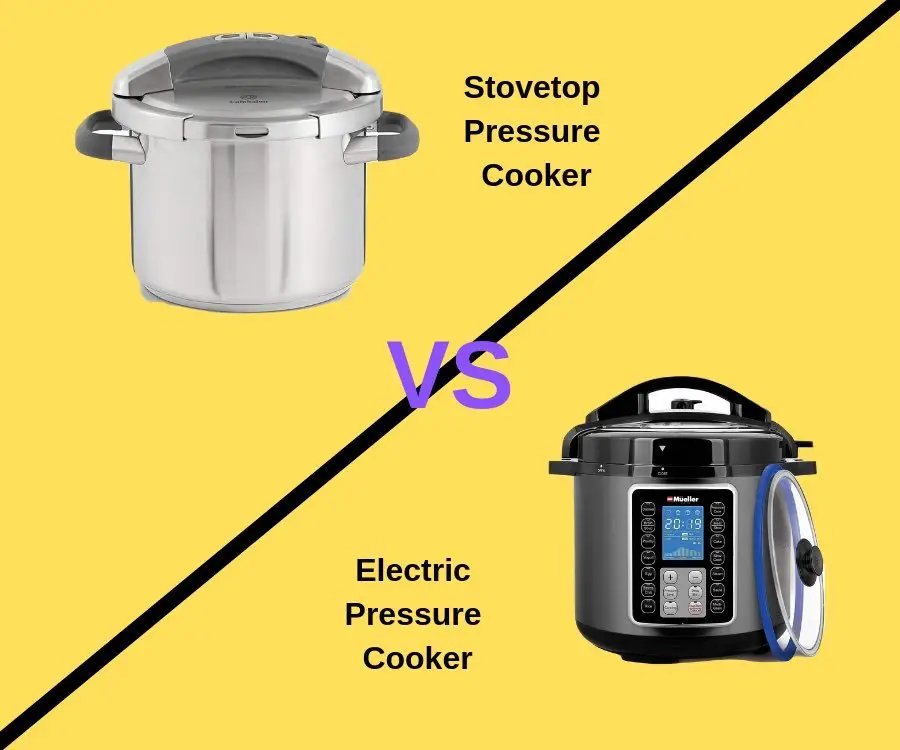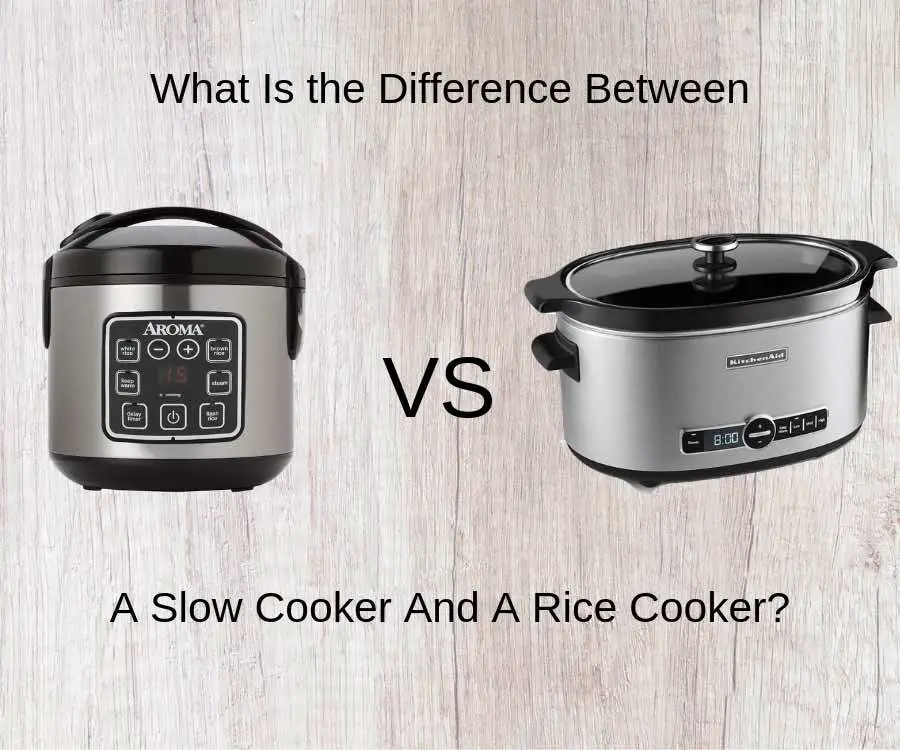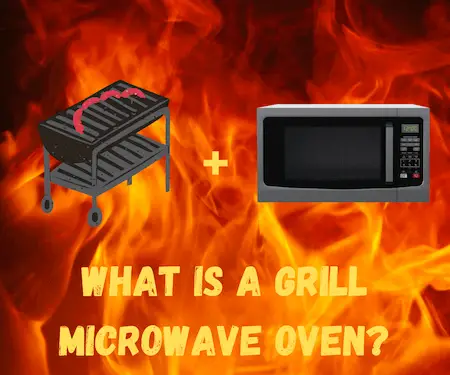I regularly see people asking the difference between all kinds of kitchen appliances online and in forums. I’ve previously written about some other differences between appliances, and in this post you will find all of the information you need about to work out the differences between a dutch oven vs pressure cooker.
So what is the main difference between a dutch oven vs pressure cooker? A dutch oven is an enamel coated cast iron pot that can be used for soups, roasting, boiling and frying. It is useable both on a cooker top or in the oven. A pressure cooker uses high pressure steam in a sealed pot to cook foods quickly. You can get both stovetop and electric pressure cookers.
Whilst the above gives you the most basic of answers to the question of a dutch oven vs pressure cooker, it by no means covers all of the information.
Read on below to find out more and see all of the differences I found between the two, including advantages and disadvantages.
Dutch Oven Vs Pressure Cooker (What is the difference?)
When I was looking at these two different appliances, the most obvious and clear difference is the way in which both appliances cook food. There are other notable differences two though.
If you are on a budget, it is more likely that you will be buying a pressure cooker. These tend to work out significantly cheaper.
Before we dive into other differences such as price, size, advantages and disadvantages, let’s take a look at how they stack up against each other in terms of functionality and cooking processes.
How Does A Dutch Oven Work?
A dutch oven, thought to be invented by and named after Pennsylvania Dutch, is a cylindrical ceramic or cast iron cooking pot usually coated in enamel. They are also known as French ovens, cocottes and sometimes casserole dishes.
The dutch oven has a tight fitting lid, and seasoning it correctly makes it virtually non-stick. You can cook both on a stovetop and in the oven, making it extremely versatile. You can begin cooking with it on the stove and transfer into the oven very easily.
The cast iron material used in a dutch oven means that it distributes radiant heat evenly throughout whatever is being cooked. The tight fitting lid allows for the retention of moisture in your dishes.
So the dutch oven is used either on a stovetop or in an oven to cook a variety of dishes. This allows for even, radiant heat to cook your food thoroughly whilst retaining moisture.
The versatile nature of the dutch oven means that it lends itself well to being able to cook a wide variety of dishes using a number of methods. It can be used for:
- Frying
- Roasting
- Casseroles
- Soups
- Stews
- Bread making
It may surprise you to read that its is possible to use a dutch oven to bake bread and for other types of baking. The tight fitting lid allows for the retention of steam in the cooking pot.
This steam is essential for the baking of bread. The dutch oven works well in trapping this steam in alongside the bread. This allows for the yeast to work and for the bread to grow at just the right speed.
How Does A Pressure Cooker Work?
As I mentioned above, there are two different types of pressure cookers. You can get both a stovetop and an electric pressure cooker. Both work on the same principle of using steam to create high levels of pressure to cook food throughly and quickly.
The pressure in these cookers is measured in pounds per square inch (PSI). I won’t go into too much detail about what this means, but if you are interested I found this article which explains this in much more detail.
Alongside the food being cooked in a pressure cooker, a certain amount of liquid, usually water is added as well. Once you turn the pressure cooker on, the temperature rises quickly and steam builds up inside with no place to escape.
The pressure cooker takes this boiling water to a higher temperature, causing food to be cooked much more quickly. Stovetop pressure cookers usually have two heat settings, with the higher setting able to take the pressure inside the cooker up to 15 PSI.
It is this extremely high pressure that cooks foods very quickly. The boiling point of the water inside the pressure cooker can reach up to 250 F, much higher than the normal boiling point of 212 F. Once the optimum temperature is reached, a valve will open to release some of the steam and pressure, keeping the food then at an even temperature.
The raised temperature of the pressure cooker not only allows for faster cooking times, but can also help to tenderise tougher foods such as thick cuts of meat. The high pressure environment can inject moisture into the food as it cooks, allowing it to become tender much more quickly.
In contrast to their stovetop counterparts, electric pressure cookers have a variety of heat settings ranging from 6 to 15 PSI, although most experienced pressure cooker users will tell you that they tend not to reach a true 15 PSI, and so will tend to take longer to cook with than a stovetop pressure cooker.
Difference In Size Between A Dutch Oven And Pressure Cooker
Both dutch ovens and pressure cookers come in a variety of sizes. Which size you go for will depend on a number of factors such as the size of your kitchen, the number of people you are cooking for and the price you are willing to spend. Below is just a quick look into the different sizes of both you can buy, helping you to decide which one might be right for you in terms of size at least.
Dutch Oven Sizes
Whilst dutch ovens tend usually to be cylindrical in shapes, they can also be round, square and rectangular in shape. Dutch ovens can range from as small as 1/4 quart (a quart is a unit of liquid equal to a quarter of a gallon or 2 pints) to around 15 quarts. Below is a quick guide to dutch oven sizes, what you might use them for, helping you to see if it’s going to be the right size for your kitchen and/or your family:
- Under 2 quarts – Best for making individual sides such as mac and cheese or desserts such as creme brulee. this is best for individual portions, and very small for storage purposes.
- 2-3 quarts – Depending on what you are cooking, you can expect to get maybe 3 to 4 servings with a dutch oven of this size. This size is great for cooking rice and pasta dishes.
- 3-5 quarts – You can expect to get approximately 3 to 5 servings with dutch ovens of this size, making ideal for making one pot dinners for a family of say 2 to 4.
- 5-6 quarts – This is what most people feel is the ideal dutch oven size. You can expect to get between 5 and 7 servings with a dutch oven of this size.
- 6-10 quarts – On the larger side, you can expect to get between 8 and 14 servings with a dutch oven of this size. Great for making large batches of soup and stew too!
- 13-15 quarts – This is most ideal for catering for large dinner parties. you can expect to get between 15 and 20 servings using one of these dutch ovens. Bear in mind that it will take up a lot of space in your kitchen!
Pressure Cooker Sizes
Similar to the dutch ovens discussed above, pressure cookers come in a variety of sizes ranging from around 4 quarts all the way up to a massive 20 quarts. hers’w what you can expect from the different sizes in terms of the amount of food that can be cooked:
- Up to 5 quarts – Smaller pressure cookers such as this are ideal for between 1 and 2 people. The great thing about these is that they do not take up too much of your kitchen space!
- 5 to 7 quarts – This is probably the most popular size of pressure cooker. you can expect to get between 3 and 7 servings using a pressure cooker of this size, depending on what you cook.
- 7 to 10 quarts – This is the ideal size for a large family. you can comfortably cook for groups larger than 6 with a pressure cooker of this size, with food leftover as well.
- 10 quarts or bigger -Unless you are cooking for absolutely huge dinner parties, this probably isn’t the pressure cooker for you. A pressure cooker 10 quarts or over would comfortably cook for more than 15 people. It would take up a huge amount of space in your kitchen!
Difference In Cooking Time Between A Dutch Oven And Pressure Cooker
There is no way I could go into a huge amount of detail about the cooking times of both of these appliances. I’ll save that for another post at least.
Below is just a small amount of information to help guide you in terms of the cooking times of a dutch oven vs pressure cooker.
In the simplest of terms a dutch oven is going to take a lot longer to cook dishes than a pressure cooker will. Pressure cookers are more suited to cooking things quickly, with the high pressure approach discussed above.
A pressure cooker is ideal for those dishes that you want to cook quickly, whereas a dutch oven is going to be more useful for dishes that take require to simmer for longer to cook properly.
Dutch Oven Vs Pressure Cooker – Differences In Price
If you are choose between a dutch oven and pressure cooker, it’s useful to know how much you should expect to spend on these right? The truth is there is huge variance both between the two and within each category. Below is a very rough breakdown of what you can expect to pay at the lower, medium and higher end of dutch oven vs pressure cooker:
How Much Does A Dutch Oven Cost?
Depending on the size and make of the dutch oven you purchase, you can expect there to be a huge variance in the cost.
Below are just a couple of examples at opposite ends of the market.
The Lodge EC6D43 Enameled Cast Iron Dutch Oven is a great choice and won’t break the bank. It is available in a number of sizes ranging from 1.5 t 7.5 quarts, and starts under the $60 mark.If price isn’t a problem for you, there are some really expensive dutch ovens out there. I guess you get what you pay for, and this Le Creuset LS2501-246MSS Signature Enameled Cast-Iron Round Dutch Oven certainly fits into that category. This 4.5 quart oven comes in a number of colors, and is made by Le Creuset, regarded as the best when it comes to dutch ovens.
How Much Does A Pressure Cooker Cost?
As mentioned before, there are essentially two different types of pressure cookers you could buy, depending on your needs and preference. I’ve split these into stovetop and electric pressure cookers.
Stovetop Pressure Cooker Prices
At the cheaper end of the market for stovetop pressure cookers you can get this lovely T-fal Pressure Cooker for somewhere around about the $75 mark at the time of writing, although I think this was originally on sale for $99.99. This is a 6.3 quart pressure cooker capable of cooking up to 15 PSI, with two heat settings. A great starter stovetop pressure cooker.
Again at the higher end of the market, there are some really expensive models. The Fissler FISS-AMZ126BOM vitaquick stovetop pressure cooker is 10.6 quarts in size (although other sizes are available), is suitable for all types of stovetop and is dishwasher safe, and is made form stainless steel with a glass lid.
Electric Pressure Cookers
At the base end, you can easily get a great electric pressure cooker for around about $50 to $60. This Gourmia GPC400 is at the cheaper end of the market, but is a great pressure cooker with a ton of versatility. The cheapest model is 4 quarts in size. You can also buy this in a 6 quart and 8 quart size, and has 13 cook modes. A perfect cheap starter electric pressure cooker.
At the other end of the scale you could easily spend somewhere close to the $200 dollar mark with this CHEF iQ Multi-Functional Smart Pressure Cooker. This electric pressure cooker is 6 quarts in size, and comes completes a wifi app. It has over 300 cooking presets and is really capable of cooking just about anything!
Advantages and Disadvantages Of Cooking With A Dutch Oven
Dutch Oven Advantages
- The biggest advantage of using a dutch oven is the wide variety of cooking methods such as:
- Roasting
- Frying
- baking
- Making soups and stews
- Making casseroles
- Cooking with a dutch oven means you can cook both on the stovetop and in the oven. Means less cookware used so less cleaning.
- Dutch ovens are also very simple and easy to clean.
- Food cooks thoroughly due to the even radiant heat spread throughout the contents of the dutch oven.
- If you look after your dutch oven properly it can last for many years due to the hard wearing nature.
- If seasoned properly they won’t rust, and are virtually non-stick.
- With the tight fitting lid, food retains it’s moisture.
Dutch Oven Disadvantages
I found it difficult to come up with any disadvantages of using dutch ovens.
- Whilst they can be expensive, they can last a very long time if looked after properly, and are very versatile.
- In comparison to a pressure cooker, cooking time will be a lot longer. I would assume that you would cook the types of food that a pressure cooker would not do justice to. For this reason I think that a longer cooking time is acceptable.
Advantages and Disadvantages Of Cooking With A Pressure Cooker
Pressure Cooker Advantages
- Pressure cookers will cook food very quickly.
- The pressure cooker retains moisture in the food due to the high steam environment.
- Using a pressure cooker allows for more retention of nutrients compared to boiling.
- The electric version of pressure cookers have a huge amount of versatility in terms of what can be cooked.
Pressure Cooker Disadvantages
- It is very easy to overcook food with a pressure cooker.
- You can’t check on food while it is cooking, as to do this would release the pressure and moisture.
Conclusion
I hope this post has helped to get an understanding of the differences between dutch ovens and pressure cookers. As you can see, there are advantages and disadvantages to both. If you are looking for a relatively cheap way to cook food quickly, invest in a pressure cooker.
If you are willing to spend the money, and don’t mind the cooking time, investing in a dutch oven will give you versatility. Looking after it after properly means it should last many years in your kitchen.

